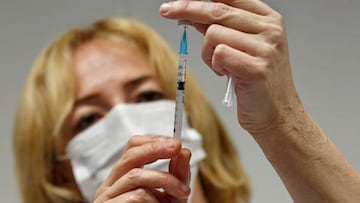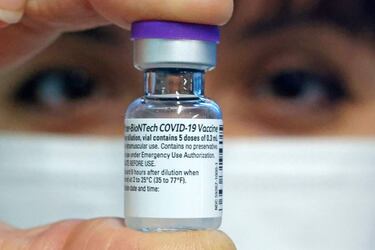What are the differences between Moderna and Pfizer’s vaccines?
While both the Moderna and Pfizer vaccine are based on mRNA technology and have shown efficacy rates of over 90%, there are some differences between the two.

Pfizer/BioNTech’s vaccine became the first candidate to receive US FDA emergency-use authorization on 11 December in what served as a historic step in the fight against the coronavirus pandemic. Some 2.9 million people will receive the first doses of the Pfizer vaccine, with front-line health care workers and the elderly identified as the top priority.
Another big boost for the US vaccination program came a week later when the FDA issued emergency-use authorization for a second vaccine developed by Moderna on Friday 18 December, the same day that a number of high-profile US political figures rolled up their sleeves to receive their first dose of the Pfizer vaccine, including vice-president Mike Pence.
The emergency use authorization for Pfizer’s vaccine is for people aged 16 and older, while Moderna’s has been authorized for people aged 18 and older. Like the Pfizer vaccine, states are expected to put health care workers and elderly nursing-home residents at the top of the queue for the Moderna vaccine. Authorization of Moderna’s candidate will allow for the shipment of millions more doses across the United States over the coming days.
“With the availability of two vaccines now for the prevention of COVID-19, the FDA has taken another crucial step in the fight against this global pandemic that is causing vast numbers of hospitalizations and deaths in the United States each day,” said FDA Commissioner Stephen M. Hahn, M.D.
“Through the FDA’s open and transparent scientific review process, two COVID-19 vaccines have been authorized in an expedited timeframe while adhering to the rigorous standards for safety, effectiveness, and manufacturing quality needed to support emergency use authorization that the American people have come to expect from the FDA.”

Similarities between Moderna and Pfizer vaccines
Technology: Both the Pfizer and Moderna vaccines are based on novel messenger RNA (mRNA) technology, with Pfizer’s vaccine becoming the first-ever mRNA vaccine to receive FDA authorization. This technology is based on harnessing RNA – the molecule that cells naturally use to carry DNA’s instructions to cells’ protein-building machinery – as a therapeutic agent.
As reported by Reuters: “Both the Pfizer/BioNTech and Moderna vaccines target the crown-like spikes on the surface of the coronavirus that it uses to break into healthy human cells. The spikes also give the family of viruses their distinctive name.”
Efficacy: Thanks to this mRNA technology, both vaccines have also shown staggering efficacy rates. The Pfizer vaccine showed efficacy of 95% (measured starting from seven days after the second dose was administered), while the Moderna vaccine was 94.1% effective (measured starting from 14 days after the second dose). In comparison, the Oxford/AstraZeneca vaccine, which is also nearing approval in the UK, has shown an efficacy rate of 70%.
Little known on transmission prevention efficacy: While both the Moderna and Pfizer vaccines have proven incredibly effective in mitigating symptoms and severe illness, it is still unclear how effective either vaccine is at preventing someone getting infected and the subsequent transmission of the virus. As a result, recipients of both vaccines will be told to continue wearing masks and following all recommended measures to prevent transmission.
Number of shots required: Both vaccines require two shots, the main dose followed by a booster shot. The period between doses for Moderna’s vaccine is 28 days, while for Pfizer’s it is 21 days.

Differences between Moderna and Pfizer vaccines
Vaccine quantities per dose: Pfizer’s vaccine contains 30mg per does, while 100mg of vaccine are administered in each Moderna shot.
Cold Storage: One of the main advantages of Moderna’s vaccine over Pfizer’s is related to long-term storage temperatures. Moderna’s vaccine can be stored at standard freezer temperatures of -20 Celsius (-4 Fahrenheit) for up to six months. After thawing out, it can be kept in a refrigerator for up to 30 days.
Related stories
The Pfizer vaccine represents a larger logistical challenge as it must be kept at ultra-cold temperatures of minus 70 degrees Celsius (-94 Fahrenheit), after which it can be stored in a refrigerator for 5 days. As a result, the Pfizer vaccine must be transported in dry ice to keep it at the necessary temperature.
Side effects: Neither vaccine has been associated with long-term side effects, however they both have been known to cause slightly different short-term side effects. Moderna’s vaccine has been linked with slightly more severe cases of fatigue, headache and fever than that of Pfizer, especially in people younger than 65. Pfizer’s vaccine, meanwhile, has also been associated with a few cases of severe allergic reactions, with at least two clinical trial volunteers in Alaska and the UK reporting severe allergic reactions after receiving the shot.

